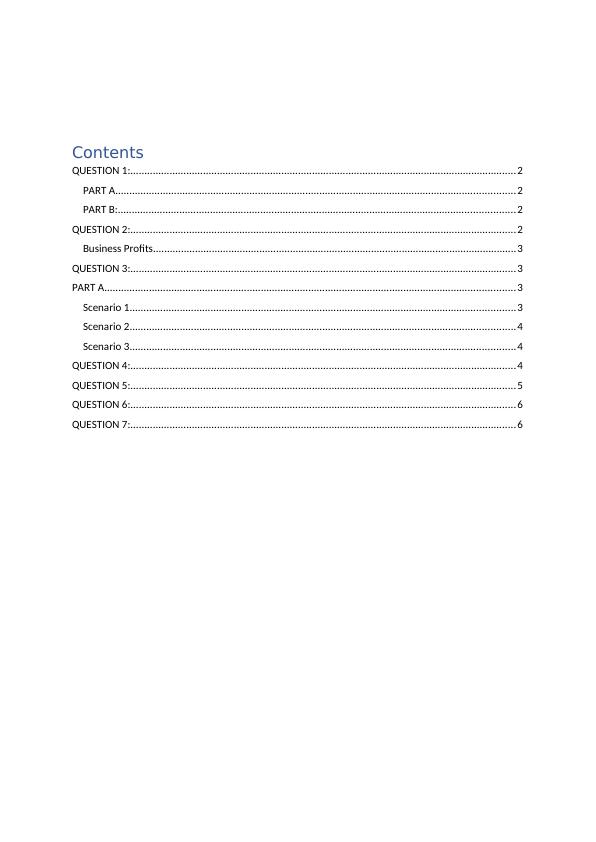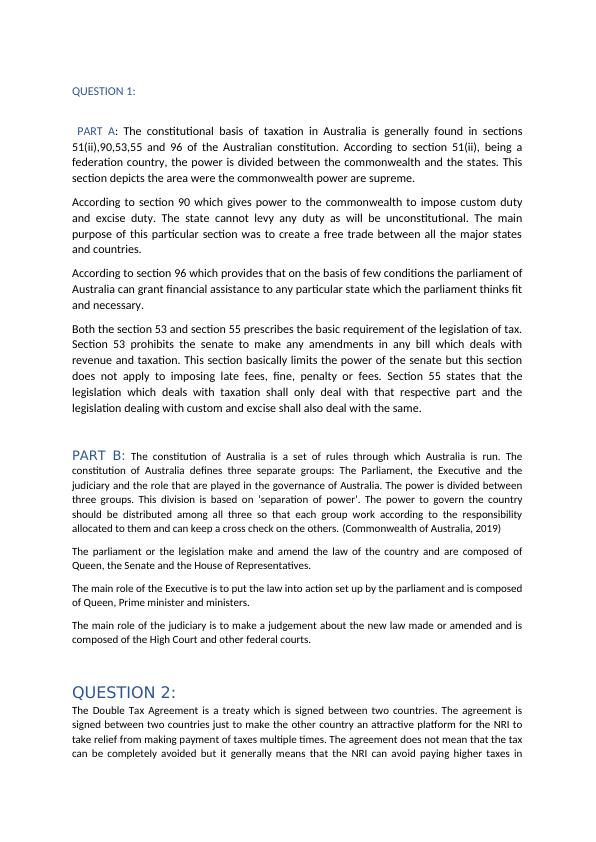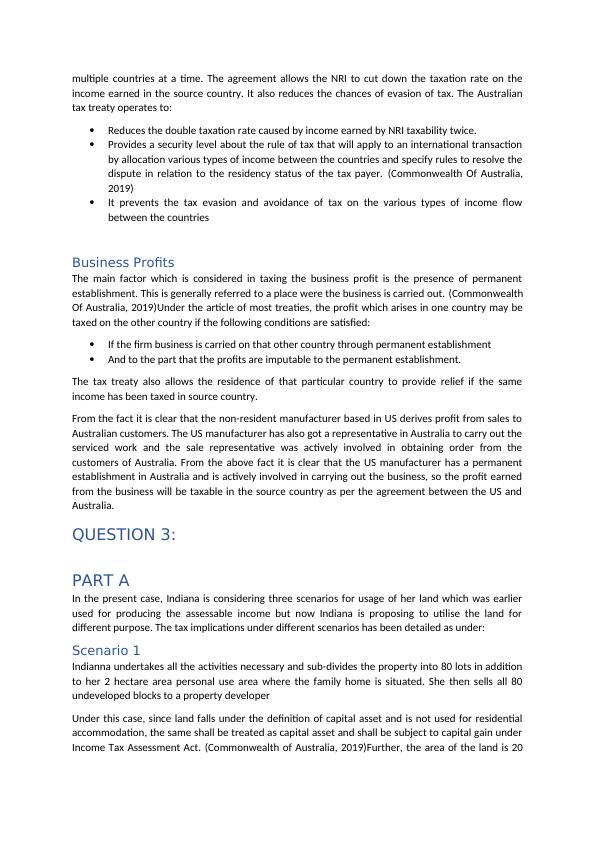Understanding the Constitutional Basis of Taxation in Australia
Added on 2023-02-01
8 Pages2821 Words38 Views
Contents
QUESTION 1:..........................................................................................................................................2
PART A...............................................................................................................................................2
PART B:..............................................................................................................................................2
QUESTION 2:..........................................................................................................................................2
Business Profits..................................................................................................................................3
QUESTION 3:..........................................................................................................................................3
PART A...................................................................................................................................................3
Scenario 1..........................................................................................................................................3
Scenario 2..........................................................................................................................................4
Scenario 3..........................................................................................................................................4
QUESTION 4:..........................................................................................................................................4
QUESTION 5:..........................................................................................................................................5
QUESTION 6:..........................................................................................................................................6
QUESTION 7:..........................................................................................................................................6
QUESTION 1:..........................................................................................................................................2
PART A...............................................................................................................................................2
PART B:..............................................................................................................................................2
QUESTION 2:..........................................................................................................................................2
Business Profits..................................................................................................................................3
QUESTION 3:..........................................................................................................................................3
PART A...................................................................................................................................................3
Scenario 1..........................................................................................................................................3
Scenario 2..........................................................................................................................................4
Scenario 3..........................................................................................................................................4
QUESTION 4:..........................................................................................................................................4
QUESTION 5:..........................................................................................................................................5
QUESTION 6:..........................................................................................................................................6
QUESTION 7:..........................................................................................................................................6

QUESTION 1:
PART A: The constitutional basis of taxation in Australia is generally found in sections
51(ii),90,53,55 and 96 of the Australian constitution. According to section 51(ii), being a
federation country, the power is divided between the commonwealth and the states. This
section depicts the area were the commonwealth power are supreme.
According to section 90 which gives power to the commonwealth to impose custom duty
and excise duty. The state cannot levy any duty as will be unconstitutional. The main
purpose of this particular section was to create a free trade between all the major states
and countries.
According to section 96 which provides that on the basis of few conditions the parliament of
Australia can grant financial assistance to any particular state which the parliament thinks fit
and necessary.
Both the section 53 and section 55 prescribes the basic requirement of the legislation of tax.
Section 53 prohibits the senate to make any amendments in any bill which deals with
revenue and taxation. This section basically limits the power of the senate but this section
does not apply to imposing late fees, fine, penalty or fees. Section 55 states that the
legislation which deals with taxation shall only deal with that respective part and the
legislation dealing with custom and excise shall also deal with the same.
PART B: The constitution of Australia is a set of rules through which Australia is run. The
constitution of Australia defines three separate groups: The Parliament, the Executive and the
judiciary and the role that are played in the governance of Australia. The power is divided between
three groups. This division is based on ‘separation of power’. The power to govern the country
should be distributed among all three so that each group work according to the responsibility
allocated to them and can keep a cross check on the others. (Commonwealth of Australia, 2019)
The parliament or the legislation make and amend the law of the country and are composed of
Queen, the Senate and the House of Representatives.
The main role of the Executive is to put the law into action set up by the parliament and is composed
of Queen, Prime minister and ministers.
The main role of the judiciary is to make a judgement about the new law made or amended and is
composed of the High Court and other federal courts.
QUESTION 2:
The Double Tax Agreement is a treaty which is signed between two countries. The agreement is
signed between two countries just to make the other country an attractive platform for the NRI to
take relief from making payment of taxes multiple times. The agreement does not mean that the tax
can be completely avoided but it generally means that the NRI can avoid paying higher taxes in
PART A: The constitutional basis of taxation in Australia is generally found in sections
51(ii),90,53,55 and 96 of the Australian constitution. According to section 51(ii), being a
federation country, the power is divided between the commonwealth and the states. This
section depicts the area were the commonwealth power are supreme.
According to section 90 which gives power to the commonwealth to impose custom duty
and excise duty. The state cannot levy any duty as will be unconstitutional. The main
purpose of this particular section was to create a free trade between all the major states
and countries.
According to section 96 which provides that on the basis of few conditions the parliament of
Australia can grant financial assistance to any particular state which the parliament thinks fit
and necessary.
Both the section 53 and section 55 prescribes the basic requirement of the legislation of tax.
Section 53 prohibits the senate to make any amendments in any bill which deals with
revenue and taxation. This section basically limits the power of the senate but this section
does not apply to imposing late fees, fine, penalty or fees. Section 55 states that the
legislation which deals with taxation shall only deal with that respective part and the
legislation dealing with custom and excise shall also deal with the same.
PART B: The constitution of Australia is a set of rules through which Australia is run. The
constitution of Australia defines three separate groups: The Parliament, the Executive and the
judiciary and the role that are played in the governance of Australia. The power is divided between
three groups. This division is based on ‘separation of power’. The power to govern the country
should be distributed among all three so that each group work according to the responsibility
allocated to them and can keep a cross check on the others. (Commonwealth of Australia, 2019)
The parliament or the legislation make and amend the law of the country and are composed of
Queen, the Senate and the House of Representatives.
The main role of the Executive is to put the law into action set up by the parliament and is composed
of Queen, Prime minister and ministers.
The main role of the judiciary is to make a judgement about the new law made or amended and is
composed of the High Court and other federal courts.
QUESTION 2:
The Double Tax Agreement is a treaty which is signed between two countries. The agreement is
signed between two countries just to make the other country an attractive platform for the NRI to
take relief from making payment of taxes multiple times. The agreement does not mean that the tax
can be completely avoided but it generally means that the NRI can avoid paying higher taxes in

multiple countries at a time. The agreement allows the NRI to cut down the taxation rate on the
income earned in the source country. It also reduces the chances of evasion of tax. The Australian
tax treaty operates to:
Reduces the double taxation rate caused by income earned by NRI taxability twice.
Provides a security level about the rule of tax that will apply to an international transaction
by allocation various types of income between the countries and specify rules to resolve the
dispute in relation to the residency status of the tax payer. (Commonwealth Of Australia,
2019)
It prevents the tax evasion and avoidance of tax on the various types of income flow
between the countries
Business Profits
The main factor which is considered in taxing the business profit is the presence of permanent
establishment. This is generally referred to a place were the business is carried out. (Commonwealth
Of Australia, 2019)Under the article of most treaties, the profit which arises in one country may be
taxed on the other country if the following conditions are satisfied:
If the firm business is carried on that other country through permanent establishment
And to the part that the profits are imputable to the permanent establishment.
The tax treaty also allows the residence of that particular country to provide relief if the same
income has been taxed in source country.
From the fact it is clear that the non-resident manufacturer based in US derives profit from sales to
Australian customers. The US manufacturer has also got a representative in Australia to carry out the
serviced work and the sale representative was actively involved in obtaining order from the
customers of Australia. From the above fact it is clear that the US manufacturer has a permanent
establishment in Australia and is actively involved in carrying out the business, so the profit earned
from the business will be taxable in the source country as per the agreement between the US and
Australia.
QUESTION 3:
PART A
In the present case, Indiana is considering three scenarios for usage of her land which was earlier
used for producing the assessable income but now Indiana is proposing to utilise the land for
different purpose. The tax implications under different scenarios has been detailed as under:
Scenario 1
Indianna undertakes all the activities necessary and sub-divides the property into 80 lots in addition
to her 2 hectare area personal use area where the family home is situated. She then sells all 80
undeveloped blocks to a property developer
Under this case, since land falls under the definition of capital asset and is not used for residential
accommodation, the same shall be treated as capital asset and shall be subject to capital gain under
Income Tax Assessment Act. (Commonwealth of Australia, 2019)Further, the area of the land is 20
income earned in the source country. It also reduces the chances of evasion of tax. The Australian
tax treaty operates to:
Reduces the double taxation rate caused by income earned by NRI taxability twice.
Provides a security level about the rule of tax that will apply to an international transaction
by allocation various types of income between the countries and specify rules to resolve the
dispute in relation to the residency status of the tax payer. (Commonwealth Of Australia,
2019)
It prevents the tax evasion and avoidance of tax on the various types of income flow
between the countries
Business Profits
The main factor which is considered in taxing the business profit is the presence of permanent
establishment. This is generally referred to a place were the business is carried out. (Commonwealth
Of Australia, 2019)Under the article of most treaties, the profit which arises in one country may be
taxed on the other country if the following conditions are satisfied:
If the firm business is carried on that other country through permanent establishment
And to the part that the profits are imputable to the permanent establishment.
The tax treaty also allows the residence of that particular country to provide relief if the same
income has been taxed in source country.
From the fact it is clear that the non-resident manufacturer based in US derives profit from sales to
Australian customers. The US manufacturer has also got a representative in Australia to carry out the
serviced work and the sale representative was actively involved in obtaining order from the
customers of Australia. From the above fact it is clear that the US manufacturer has a permanent
establishment in Australia and is actively involved in carrying out the business, so the profit earned
from the business will be taxable in the source country as per the agreement between the US and
Australia.
QUESTION 3:
PART A
In the present case, Indiana is considering three scenarios for usage of her land which was earlier
used for producing the assessable income but now Indiana is proposing to utilise the land for
different purpose. The tax implications under different scenarios has been detailed as under:
Scenario 1
Indianna undertakes all the activities necessary and sub-divides the property into 80 lots in addition
to her 2 hectare area personal use area where the family home is situated. She then sells all 80
undeveloped blocks to a property developer
Under this case, since land falls under the definition of capital asset and is not used for residential
accommodation, the same shall be treated as capital asset and shall be subject to capital gain under
Income Tax Assessment Act. (Commonwealth of Australia, 2019)Further, the area of the land is 20

End of preview
Want to access all the pages? Upload your documents or become a member.
Related Documents
Understanding Australian Constitution and Taxation Lawslg...
|10
|2979
|85
Understanding Australian Constitution and Taxation Lawslg...
|9
|2976
|96
Australian Taxation Law – PDFlg...
|12
|2610
|220
Australian Taxation Law- Assignmentlg...
|11
|3079
|459
Taxation Lawlg...
|12
|3033
|55
Taxation Lawlg...
|12
|2985
|62
